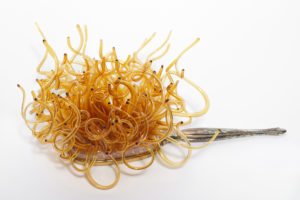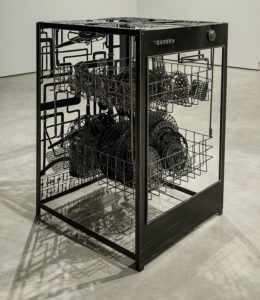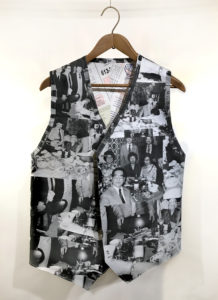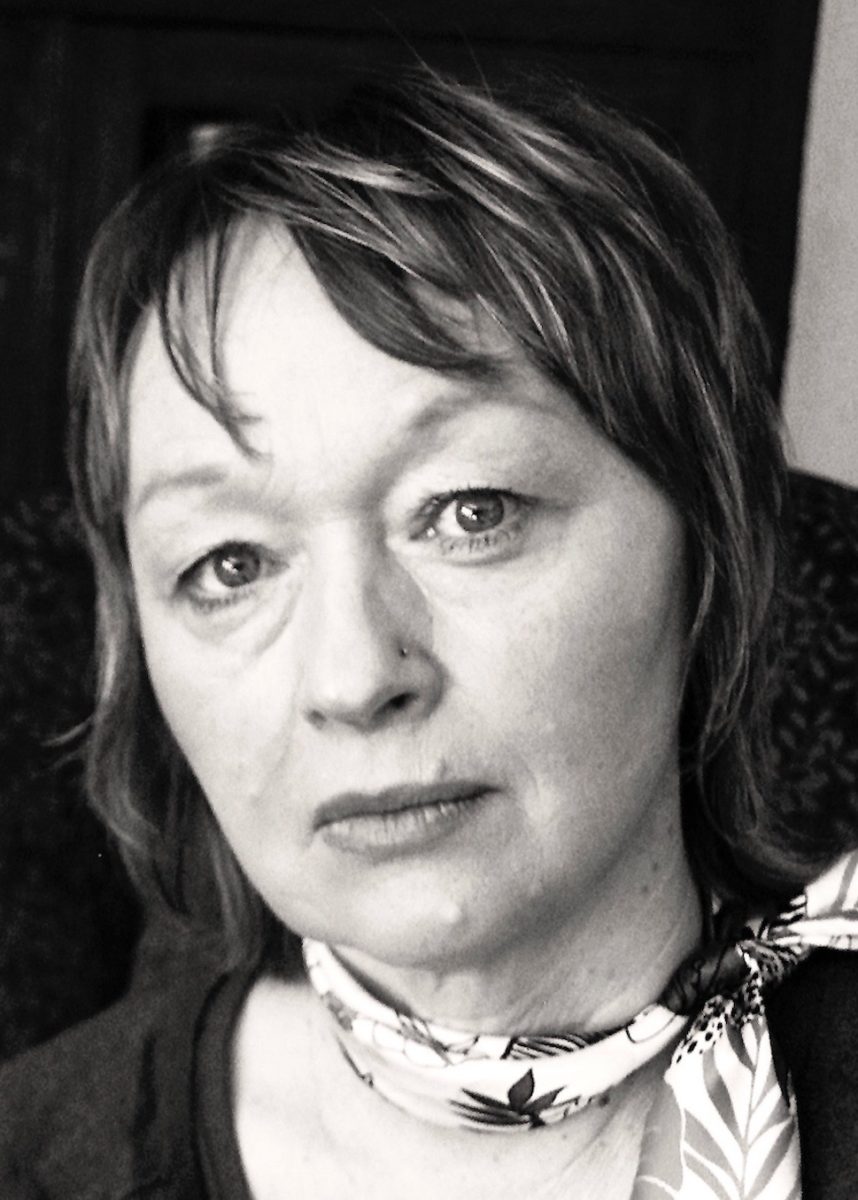This year’s exhibition of new acquisitions by the City of Ottawa is dominated by artworks that are not actually there.
They are, rather, spread from one side of the city to the other, as commissions in the stations along the new LRT line. It’s likely that not a single one of the commissions would even fit into the two spaces that house the exhibition, those being the City Hall art gallery and Karsh-Masson Gallery, both in City Hall. For one thing, the commissions tend to be big and, further, they’re designed to fit the dimensions of each station.
So how did exhibition curators get the immovable commissions into the galleries? They got creative, by bringing in trace elements of the commissions and arranging them along a scaled-down representation of the line itself, printed along the lengths of two walls. Each LRT stop is represented by a dot on the line, as on a transit map. By each dot are photographs of the commissions in situ, and a varied lot they are.

Anna Williams. Déjeuner Sur L’Herbe. Courtesy City of Ottawa.
It starts at Blair Station in the east, with the thousands of small “flags” of coloured glass in Lightscape, by cj fleury and Catherine Widgery, and it ends at Tunney’s Pasture in the west, with much larger — and much smaller — bits of coloured glass in Gradient Space, by Derek Root.
Between the two are various media, such as the historical narrative of Andrew Morrow’s prints at St-Laurent, the light installation by Kenneth Emig at UOttawa, and the hand-painted paddles by artists Simon Brascoupé, Emily Brascoupé-Hoefler, Sherry-Ann Rogers, Doreen Steves and Sylvia Tennisco at Pimisi station.
The Pimisi installation, titled Algonquin Canoe, is one that gets added attention, with various pieces of the conceptual process displayed, including several small and beautiful studies for the dozens of paddles that make up the final work.

Charlynne Lafontaine. No More Tears. Courtesy City of Ottawa.
All of this is in Karsh-Masson Gallery, which is given over to commissions and donations. Direct purchases — the larger portion of 2019 acquisitions to the city’s collection — are gathered in the adjacent City Hall gallery. It’s one way of instilling some order on an annual exhibition that always is, by its nature, a mish-mash of Ottawa-made art that is otherwise related only by having all come into the city’s collection in the same year.
That said, the curators have found logical and complementary ways to group works. Kyle Bustin’s graffiti-esque wall installation and Natalie Bruvels’ large painting are different styles and materials, but they so share a bright palette that one might wonder if they inspired each other.
One wall is filled with portraits, including Neeko Paluzzi’s photographs of himself and his partner and portraits or conceptual self portraits by Marisa Gallemit, Katherine Takpannie, Meryl McMaster and others. On the other side of the room are two works in metal, one framed and hung on the wall, by Jinny Yu, and another free-standing work by Anna Frian.

Anna Frian. Jet Clean. Courtesy City of Ottawa.
Frian’s piece, titled Jet Clean, is a metal skeleton of a full-size home dishwasher, filled with metal flatware and dishes, each one meticulously cut with designs.
Some pieces defy groupings, as they’re unlike anything else in the exhibition. Don Kwan’s vest, of the style a waiter in a Chinese-Canadian restaurant once wore, is made of Kwan family photographs and menus from Chinese restaurants around Ottawa. Even more fragile is Charlynne Lafontaine’s No More Tears, a handheld, metal hair brush like the one your grandmother may have had on her dressing table, but with the bristles replaced by anxiously thin tendrils of yellow glass, which seem to move and writhe as if in search of something.
Nearby are Nathalie Grice’s pair of sculpted raccoons, the urban residents cast here with graffiti on their haunches, and looking up to four prints by Anna Williams of her trademark she-wolves enjoying le dejeuner sur l’herbe, Canadian style.

Don Kwan. Invisible Identities. Courtesy City of Ottawa.
This great variety of works can evoke a great variety of responses and emotions, though none quite like the illustrations by the late Mathieu Trudel.
Trudel, born in 1979, had a great love for the disappearing architectural style of the old commercial stripes of Vanier, Chinatown and Old Hull.
His estate donated a set of prints. Each is a drawing of a building, without background or adjacent structures, to put the focus fully on the architectural style. There’s Chez Taffy Restaurant, the Butler Motor Hotel, Steinbergs, L’Allumiere Canada Limited and others.
Trudel died in 2016, two years after an apparent (and still unsolved) hit-and-run left him with a severe concussion. It was a tragic end, yet his
infectious fondness for these old buildings and storefronts lives on, blessing us with a warm and happy sense of nostalgia.
In town: Signal: 2019 Additions to the City of Ottawa Art Collection is at Karsh-Masson Gallery to Jan. 12; at City Hall Art Gallery to Jan. 29.







